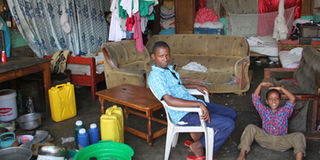Life in Uganda’s ‘little Mogadishu’

The home of one of the Somali families in Kisenyi. Most of the families have to make do with one room. Gladly they cherish living communally. PHOTOS BY ISMAIL KEZAALA
What you need to know:
Sojourn with the Somali community. Somalia may be miles away, however one needs not go that far to discover the rich cultural heritage and camaraderie of the Somalis. Jonathan Adengo spent some time with the community in Kisenyi.
It is a bright sunny morning when I descend on Kisenyi slum. The wind blows through the dusty tarmacked stretch of Malinga Road, raising dust at the busy noisy community. I keep my eyes open, not only to dodge the bodabodas passing by, but also the multitude of people rushing through the streets, carrying sack loads on their heads. In the shops, just after the Delta Petro station that has a Forex bureau occupying the building adjacent to it, men are seated in groups of three to five, drinking what I later learn is Camel milk and ovacado juice, and chatting away.
I am amazed at the fact that there are so many Somalis in the area, running nearly every business that I lay my eyes on, from supermarkets to food stalls, internet cafe’s, retail shops, save for a few drops of locals.
Located just a stone throw away from the city center, Kisenyi paints the picture of a vibrant slum with many small-scale businesses thriving. In the midst of the bustle and hustle that characterises most streets in Kampala, Kisenyi certainly lives up to this tune, the streets are noisy and crowded. Kisenyi is famous for metal works and grinding mills. To many, it’s a place where certainly only the strong hearted can survive. It is one of the dirtiest slums with rubbish and filthy blocked drainage channels marking boundaries of the tarmacked road.
A place called home
To many, Kisenyi is a shelter of thieves, pickpockets and rogues. But according to the chairman of the Somali community, Hassan Hussein, its home to over 4,000 Somali refugee nationals living in the wooden shacks and shanty residential blocks dotted across the maze of dusty streets and pot-hole ridden roads.
For them, Kisenyi is a home away from home. It is now called “Little Mogadishu” by many. They have built a budding culture and assimilated community, painting it with their Khamiis and peddling clothes, operating Forex bureaus running supermarkets and restaurants.
Children play in the nearby neighborhood and some of them study from the local schools in Kampala.
Finding a life in Uganda
As I ventured into this community, most of the Somalis I tried to speak to, seemed reserved and feared to chat with a stranger, but one Shukri, a mother of four children was glad to tell me about her life in Uganda. “We moved here 10 years back, looking for a safe place for the family,” she says. Because there was a lot of fighting and kidnaps back home, her family decided to move, first settling in Kenya. But they later joined others in Kisenyi. Her eyes light up with joy, as she watches her two children play. She might not be able to give them much, but at least, she knows they are safe.
Muhammad Dahir, 28, a supermarket attendant, says he has been a refugee in Uganda for five years now. He arrived in 2007, joining thousands of others who fled fighting back in Somalia. And yes, Uganda is a paradise of sorts.
Dahir works as an attendant at Mubarak Supermarket, of course, owned by another of his countrymen. He wishes to go back home and reunite with his family in the near future. “I am an asylum seeker and carry a card- (that identifies him as a refugee). Much as we are free here, I long to go back home,” he says.
Shukri just like Dahir, hopes to go back home someday. “People are moving back to try and rebuild their homes. We shall go back some day.” This desire is also shared by Aminah who stays in the same lodge with Shukri.
Most of the Somalis have blended in with the locals and many can speak Luganda and Kiswahili, the local means of communication. Abdi, who runs an electrical shop, says he interacts well with the local people and they form a big customer base for him.
A people that stick together
As the day progresses and the sun stands directly above, many women roam the streets totally covered up in their burka revealing only their eyes. These women operate small shanty hotels and other food stalls where they toil to earn a living.
At a restaurant just opposite the East African airways offices, there is a large drainage that flows through the restaurant carrying dirty water. Ironically none of the clients seems to take notice of this, as many continue to enjoy their meal.
At dusk, old men and the youth sit in groups on the pavements, with others seated in shanty hotels. Here, they converse amongst themselves in loud voices. Other men seat outside the shops smoking away. Sights like these show the solidarity, togetherness and unity that the Somalis have.
On any other day, you will meet a cross section of them smoking or chewing what I later learn is miraa. This sends chills down my spine. But such things mark the life of the Somalis. “That’s the typical Somali lifestyle and we are united, and we share our problems together,” says Hussein Roble, the vice chairperson of the Somali community.
On the day I visited the East African Airways offices, which mainly arrange for flights back to Somalia, I found elders dressed in Khamiis seated in large circles. It being a Friday, most of them had worn this for prayer given their strong Islamic background. Such practices are common and Roble, explains that these elders teach the young ones especially the youth about their culture. They also handle any disputes, and problems that arise amongst them.
Coping in Uganda
The Somalis I discover, are a closely knit people and many of them prefer to stay together hence they always look for settlements with their kind.
However, in spite of them being far away from home, the Somalis have maintained their culture even in a foreign country. They still practice things like drinking water using their wooden cups. Being a largely Moslems community, they conduct their prayers from the Tawhid Mosque. A primary school- Tawhid Primary school was started to provide education to the families, which also has many children usually five to 10. The school also teaches in Somali language and teaches them about their norms and way of life,” explains Hussein.
Hussein adds that they are very united and come together to solve any issues that affect them. They always meet with the elders and discuss about their future. All the different clans meet and plan everything together. This unity and bond is one of the reasons they have been able to cope with the situation back home and also help one another. They also help their people back home. The elders are also charged with settling disputes and teaching the young ones some of the Somali practices.
Camel meat, a delicacy
Camel meat is very popular in the community and a kilogramme costs Shs10,000. The camels are transported from Moroto and brought to Kampala. They are slaughtered in Kisenyi every weekend.
Roble says camel meat is very tasty especially the hump which has special oil. The camel milk is also said to be very nutritious and is known to last a long time without going bad. I was privileged to taste one of their delicacies, - Anjera, a soft like chapatti. This is served with eggs or you can also eat it sweet without the eggs. The tea served is very sweet.
The budding culture is also supported by an equally successful economic life. Hussein explains that most of them are engaged in small income generating activities. The Somalis are naturally entrepreneurial, something that has seen them step up and start up large businesses in a country that has allowed them the freedom to work and some freedom of movement. Today, they own supermarkets, guesthouses and lodges, which are popular in Kisenyi. Those who have relatives abroad also receive assistance from them in terms of money.
According to the recent documentation by The United Nations High Commissioner, there are 14,240 refugees from Somalia. Of these, Roble, says 10,000 are settled at the refugee camp in Nakivale and the other 4000 live in Kisenyi. However, he notes that most of them are returning back home.




